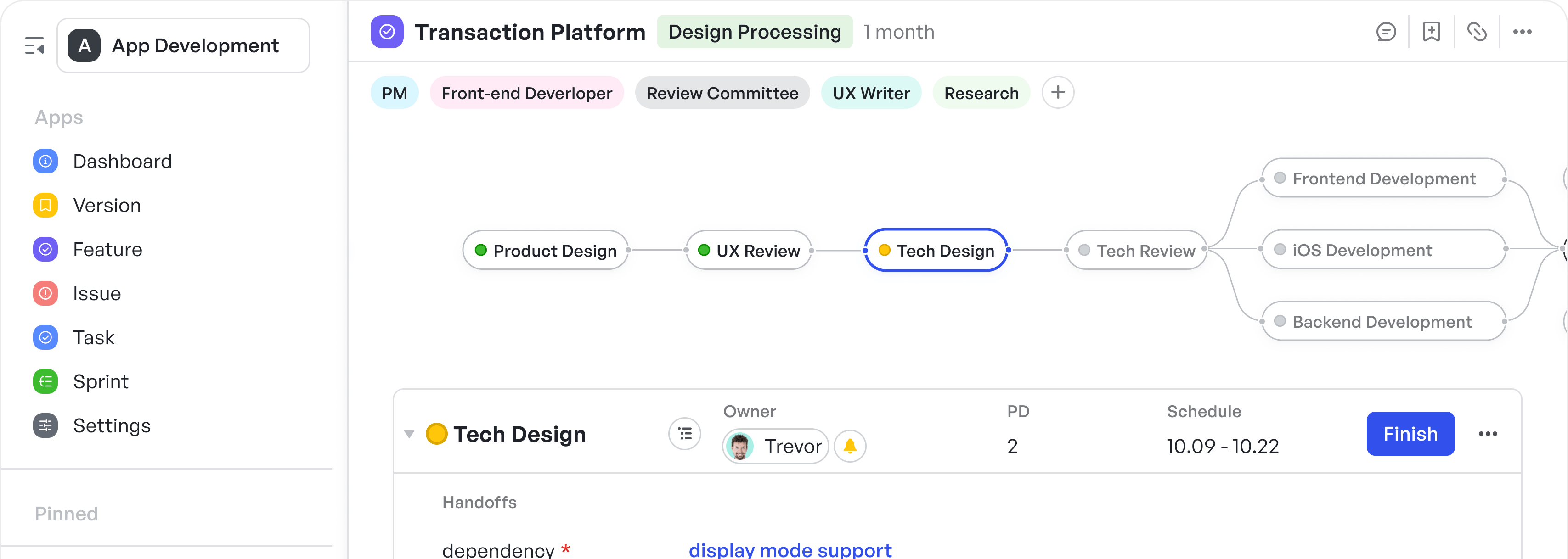What is the Project Scope?
Project scope gives your project a clear boundary, setting out specific goals and objectives, deadlines, and deliverables. It’s like a roadmap that keeps your work on track, ensuring your objectives are met without unexpected delays or extra work.
Project scope isn’t something to define alone; you need to coordinate with key stakeholders to stay aligned. For example, you’re preparing for a product launch. You’d want to touch base with relevant teams like product, design, and content to ensure everyone understands the goals.
For more complex projects, defining a change control process can be helpful, too.
250px|700px|reset
加载中,请稍后
What is a Project Scope Statement?
A project scope statement is a document that captures your project’s scope in writing. Depending on how detailed your project needs to be, this statement could either be a part of your project plan or a separate document.
If you’re collaborating with an external team or agency, you might create a statement of work (SOW) based on your project scope statement to formalize the partnership.
What is Scope Creep?
Scope creep is a condition that happens when the project’s workload expands beyond the original scope. Imagine you’re halfway through a product launch project without a clear scope statement, and a stakeholder requests a press release. Soon, another stakeholder asks for a blog post, as well. With added deliverables you hadn’t planned for, your team might experience extra stress or see delays in completing the main tasks.
When a project is hit by scope creep, you end up doing more than expected, which can mean delays, more stress, or even a dip in quality.
Creating a detailed project scope statement and sharing it early with stakeholders can help prevent scope creep. This way, everyone is aligned on what the project includes and excludes, setting clear expectations from the start.
250px|700px|reset
加载中,请稍后
The Benefits of Defining Your Project Scope Early
Defining your project scope early on is crucial for setting a strong foundation for success. Not only does it establish clear goals and expectations for everyone involved, but it also creates a structure that can minimize risks and prevent common pitfalls.
Here’s a closer look at why early scope definition can be a game-changer:
Ensuring Alignment and Clear Expectations
Establishing the project scope at the beginning ensures that everyone—clients, team members, and stakeholders—is on the same page about what the project will achieve and what it won’t cover.
Clear scope definition helps keep everyone aligned, reducing misunderstandings that can lead to scope creep or rework down the line. For example, only 40% of projects meet the initial goals, according to an IBM study.
250px|700px|reset
加载中,请稍后
Minimizing Financial and Operational Risks
Defining your project scope early minimizes risks, particularly scope creep, which is a major contributor to budget overruns. According to Quixy, 78% of projects experience timeline delays or go over budget due to scope changes introduced late in the project.
For large-scale projects, this can translate to hundreds of thousands of dollars in unplanned expenses. By identifying boundaries, deliverables, and resources initially, companies reduce the risk of surprise costs.
Setting a Structure for Success
Early scope definition clarifies project deliverables and creates a roadmap for monitoring progress, setting milestones, and managing timelines.
Research shows that teams who define the scope and plan in detail are on time and within budget compared to those who don’t have a clear structure. It also improves resource allocation, letting teams focus on priority tasks and avoid unnecessary work.
As a result, these structured projects see an increase in productivity and often achieve higher customer satisfaction rates due to consistent delivery of expectations.
8 Steps to Defining a Project Scope
It’s normal to feel like predicting every project detail at the start is impossible. But defining project scope doesn’t require a crystal ball; it just takes a clear approach.
Here’s a guide to building a simple scope statement for your project.
Step 1. Start with Your Project Objectives
Every project starts with a purpose or end goal. While it might seem like the objective is clear, putting it into words helps everyone align with the mission. A well-defined goal lays the foundation for all future decisions.
Imagine you’re working in a marketing agency, and you need to create a questionnaire template for new clients. The goal would be to create a client intake questionnaire that simplifies onboarding, helping the project team gather essential client information from the outset.
By stating the purpose explicitly, you give the project direction, making it easier to guide every subsequent step with this aim in mind.
Step 2. Make a Resource Plan
Once you’ve defined the project’s goal, think about what resources are available to achieve it. Resources can mean anything from the budget to the team’s time, tools, or other support structures.
A resource plan clarifies what’s on hand for the project and how these resources will be allocated. For instance, if your budget is limited or the team has tight schedules, these constraints will shape the scope.
Having a solid resource plan early on lets you know what’s possible and adjust the project’s scope accordingly.
Step 3. Collect Additional Project Requirements
There may be extra details, timelines, or specific needs that shape the project’s overall structure. Gather everything that might impact the project’s scope—like deliverable dates, expected milestones, or budget restrictions.
These requirements set accurate expectations and ensure clarity for everyone involved.
Step 4. Draft Your Project Scope Statement
Next, compile all your research into a project scope statement. This statement outlines what the project will and won’t include, along with the reasons why.
The format can vary—sometimes a list, a paragraph, or even a detailed SOW (statement of work) does the job. No matter its length, it should highlight project objectives and boundaries clearly.
A good place to start is by answering these questions:
- What’s the project’s purpose, and what are the main goals?
- What are the constraints? Think about budget, resources, and team members.
- What’s the timeline, and when are deliverables due?
- What’s outside the scope?
Here's an example of a project scope statement:
Example Project Scope Statement
Imagine you're tasked with developing a mobile app for a retail company to improve the shopping experience and increase customer engagement. Here’s how your project scope statement might look:
Project Objectives
- Create a customer-facing mobile app for iOS and Android that allows users to browse products, view deals, track orders, and receive personalized notifications.
Resources
- Mobile Development Team: Four developers, each dedicating 20 hours per week for 10 weeks.
- Design Team: Two UI/UX designers, each contributing 15 hours per week over six weeks.
- Product Manager: One manager providing 10 hours per week for the entire project duration.
- Quality Assurance Team: Three testers contributing 10 hours weekly from weeks 7 to 10.
- Budget: $50,000 allocated for design, development, and marketing.
Deliverables
- Fully functional mobile app for iOS and Android with product browsing, search, and order-tracking features.
- Push notification system to alert users about exclusive deals and order updates.
- User account system with profile management and purchase history.
- Integration with the company’s existing inventory and CRM systems.
Project Roadmap and Timeline
- May 1: Complete initial project planning and begin requirements gathering.
- May 15: The design team starts creating UI/UX wireframes and mockups.
- June 1 – July 15: Development team begins building core app features, with weekly check-ins for progress.
- July 15 – August 15: Begin integration of inventory and CRM systems, and QA team starts testing.
- August 20: Launch beta version for internal review and testing.
- September 1: Launch the app to the public.
Out of Scope
- Advanced AI-driven recommendations or personalization.
- Integration with third-party payment providers outside the company's current system.
- Support for mobile operating systems other than iOS and Android.
Step 5. Get Buy-In and Approval from Key Stakeholders
After drafting the scope, bring it to key stakeholders for feedback and approval. This is the perfect time for stakeholders to weigh in on any necessary changes, objectives, or clarifications.
Discussing the scope with stakeholders at this stage lets everyone understand the project’s goals, limits, and timeline, preventing potential misalignment later on.
Step 6. Establish a Change Control Process
Especially in larger projects, a change control process can help you manage inevitable adjustments without derailing the original product scope. In case any major new elements or feedback arise, the change control process allows for a structured evaluation.
For instance, create a form for submitting change requests and assign a team of key stakeholders to review and approve them. This approach helps you avoid “scope creep”—where the project expands beyond its initial scope—while allowing flexibility.
Step 7. Share Your Project Scope Statement with the Team
Once stakeholders approve the project scope, ensure the entire team has access to it.
Using a shared tool like a project management platform like Meegle ensures everyone can refer back to the scope as they work. This transparency keeps everyone aligned and helps avoid confusion.
Step 8. Refer Back to Your Project Scope Statement During the Project
Throughout the project, it’s helpful to revisit the scope statement to check progress and guard against scope creep. If team members propose changes or new elements, redirect them to the approved project scope document. Encourage them to follow the established process for changes, keeping the project aligned with its original goals.
By following these steps, defining a project scope becomes a clear, organized process, helping you stay on track from start to finish.
Project Scope Management: Key Takeaways
We’ve all been there—either a project spirals beyond what we initially imagined, or it’s a shopping trip that gets wildly out of control. It's easy to lose focus.
And if your project starts to grow beyond its initial scope, you’ll find your time, money, and resources stretched thin.
That’s where project scope management comes into play. By sticking closely to your original goals and managing the scope effectively, you can avoid those unwanted surprises that throw off your plan.
Let's walk through a few reasons why this matters so much.
- Achieving Realistic Timelines
- Achieving Realistic Timelines
Ever notice how projects tend to drag out longer than expected? You’re not alone. A PwC study found that only 2.5% of companies finish their projects on time and within budget.
250px|700px|reset
加载中,请稍后
Knowing your project’s scope upfront helps you set deadlines that you can actually meet.
Consider our grocery trip again—if you knew from the start you needed more than just eggs, you’d probably grab a cart and allow more time to shop. The same principle applies to project timelines: you can plan realistically from the get-go when you know what's required.
- Creating Accurate Budgets
- Creating Accurate Budgets
Budgeting for a project is hard enough, but it's nearly impossible if the scope keeps changing. When you define the scope, you can also set a budget that makes sense from the start.
As the project progresses, managing that scope keeps you from overspending by sticking as closely as possible to your original financial plan.
- Running Efficient Projects
- Running Efficient Projects
Who hasn’t worked on a project that just won’t end? Whether it’s a new feature request or last-minute tweaks, it feels never-ending. That’s scope creep in action.
While saying "yes" to changes might seem like the right thing to do, it often derails the entire project. Defining the scope early on and managing it throughout keeps your team focused and productive.
It also prevents that dreaded snowball effect, where the project grows and drags on without an end in sight.
Can the Project Scope Change Later On?
The project scope can change after it’s initially defined, although doing so should be carefully managed. Changes to scope, often referred to as "scope creep," if unplanned, can occur for several reasons: evolving client needs, shifting market demands, new regulatory requirements, or even discoveries made during project development that reveal additional needs.
While scope flexibility allows teams to adapt, it’s essential to control scope changes to prevent disruptions, timeline delays, and budget overruns.
To handle scope changes effectively, many organizations implement a change control process. This process sets a structured way to evaluate and approve scope adjustments, ensuring that any change aligns with project goals and resources.
For example, if a software development project discovers that additional security features are needed late in testing, adding these might be essential. However, a formal change control process allows the team to evaluate this new requirement, allocate additional budget or time as necessary, and ensure stakeholders understand the impact on the project’s timeline and cost.
Ultimately, scope changes are a reality in most projects, especially complex ones, but with a structured approach, they can be handled smoothly. This ensures the project remains aligned with the client's objectives, even as needs evolve.
How Meegle Helps with Project Scope Management
Meegle is designed with a rich set of features to streamline project scope management, making it easier for teams to plan, execute, and adapt their projects with precision.
Here’s how the platform helps with managing project scope:
Define Clear Objectives and Set Up Milestones
The first step in creating a scope is to clarify your goals. Whether you’re looking to dominate a new market, enhance user retention, or launch an innovative feature, these objectives will lay the foundation for your scope.
250px|700px|reset
加载中,请稍后
With Meegle's table view feature, you can visualize these goals in a user-friendly format, making it easy to track progress and ensure alignment across your team. You’ll receive real-time updates and insights into how your project is progressing, which helps ensure nothing is overlooked.
This way, you can adapt your strategy as needed and keep your roadmap on the right track.
Task Management with Meegle
Meegle's task management feature provides a centralized platform where team members can track progress, assign tasks, and collaborate seamlessly. By having all tasks in one place, teams can ensure that nothing is overlooked during the scope definition process.
250px|700px|reset
加载中,请稍后
As the project scope evolves, tasks can be easily updated or reassigned, ensuring alignment with new goals and preventing scope creep. This streamlined approach not only supports clarity and accountability but also keeps the team focused on the bigger picture, making it easier to achieve project milestones within the set parameters.
Project Scheduling with Meegle
The Gantt View and Member Schedule in Meegle helps teams visualize and control project timelines and dependencies, ensuring a clear schedule and manageable workflow. With this view, teams gain a clear picture of the project's entire structure, showing what needs to be done, who’s responsible, and when each phase should be completed. This structured format helps prevent scope creep.
250px|700px|reset
加载中,请稍后
Fuel progress with the full picture
This detailed layout helps define the project scope by laying out tasks in a logical sequence, making it easy to identify priorities and align resources accordingly.
As timelines shift or objectives change, the Gantt view makes it easy to assess the impact on the project scope, allowing adjustments to be made without derailing the overall plan.
The Meegle Product Lifecycle Template
250px|700px|reset
加载中,请稍后
Efficiently manage projects through the project stages to achieve success
The Meegle Project Life Cycle Template is a powerful tool that keeps project scope well-defined and manageable throughout a project’s phases—Initiation, Planning, Execution, Monitoring and Controlling, and Closing.
250px|700px|reset
加载中,请稍后
Break down the project into smaller tasks, set deadlines, and assign responsibilities during the project planning phase
For example, during the initial planning phase, the template provides sections to document stakeholder requirements, set realistic timelines, and assign resources based on the approved project scope. The phrase indicates a transition to detailed scheduling and resource allocation. Within the five parallel nodes of the planning stage, you can upload attachments, provide text descriptions of the project scope, and include budget forms and risk lists.
In execution, teams can track tasks in detail, ensuring that all work directly contributes to the original scope without diverting resources.
250px|700px|reset
加载中,请稍后
Track performance, manage changes, scope verification, and ensure project objectives are met in the project monitoring and controlling phase
The project monitoring and controlling phase runs concurrently with the project execution phase. Use this phrase to remind the team that, while the project is in progress, continuous monitoring is essential to ensure that it aligns with the project management plan.
This continuous review of objectives, tasks, and deliverables is essential for scope control, enabling project managers to avoid scope creep and maintain efficient workflow.
Manage Your Project Effortlessly With Meegle
Now that you know the risks associated with scope creep and how to prepare for it, let’s explore ways to eliminate the issue altogether.
Meegle can streamline your project processes and effectively address scope creep. With its intuitive task management features, you can easily create and assign tasks to your team members.





